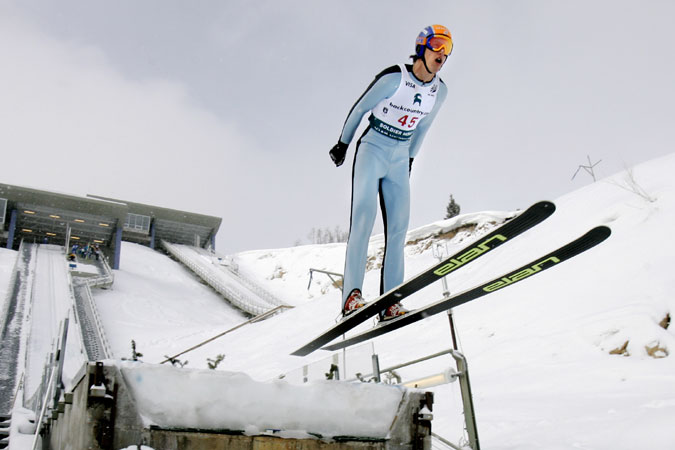Jump Form
The form a jumper is what makes a good ski jumper. Every
movement they make from, the second they start down the in-run
until their skis are stopped at the bottom of the hill,
affects the quality and length of the jump.
Starting at the top of the in-run the jumper crouches down
with their center of gravity located slightly in front of
their toes. The in-run position is tested to minimize drag and
set them up for a good takeoff. During the transition from the
steep upper part of the in-run to the takeoff the in-run
becomes concave which means that traveling at upwards of 70mph
the jumper will be subject to centrifugal forces and create
G's on the jumper. Instead of fighting the forces, the best
jumpers will let this compress them into a deeper crouch.

During the takeoff the jumper will extend from a crouch out into their flight position. The power and efficiency of this movement can make or break a jump. A well executed takeoff will be smooth but rapid. Member of the US Women's Ski Jumping Team Jessica Jerome describes this as a "long, hard push instead of a jump"

While in the air, the jumper lays out virtually
parallel to the direction of motion. This reduces drag as it
minimizes the surface area of the jumper. In the old days
people used to jump with their skis parallel underneath their
bodies. In the 1980's Jan Bokloev figured out that if you
spread your skis into a V you will create more surface area
beneath you, in doing so this allows you to create lift.
Nowadays it is common practice to jump with skis in a V
shape.The more surface area that can be created on the
underside of the jumper leads to the more lift that will be
created, causing the jumper to fly farther. The longer the ski
you jump with the more lift you will create if jumping with
the proper technique. During flight the jumper will try their
best to mimic the shape of an airplane wing, which lets them
create maximum lift.

Wind during a jump can be problematic or it can help. If it is a head wind it will actually allow the jumper to push harder against the air which can create more lift. During competition the wind speed is measured and is accounted for in scoring the competition. To much of a head wind can actually be dangerous for the jumpers, especially now that we have almost perfected the art ski jumping and most competitive jumpers are jumping further and further past K every day.
It has been found that being lighter with a
lower BMI is important to making a good jumper. Because of
this anorexia is a large problem among the ski jumping
community. To combat unhealthy eating habits The IOC
(International Olympic Committee) and the FIS (International
Ski Federation) have put limits on the length of skis
according to the BMI of the athlete